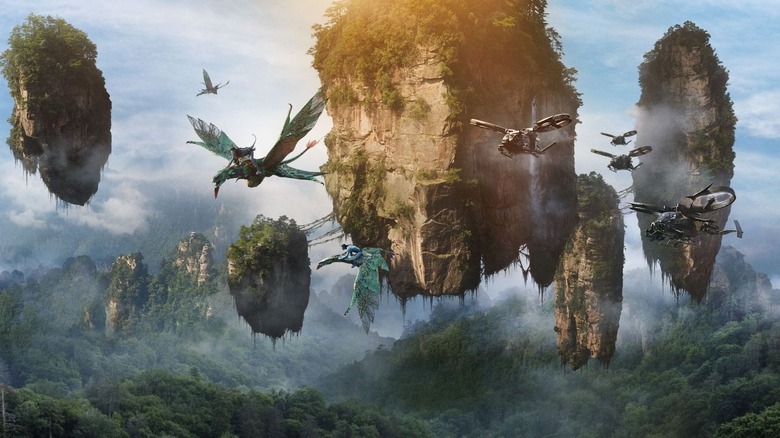The Real Forest That Inspired Avatar's Pandora
Back in 2009, James Cameron's ethereal vision propelled "Avatar" into becoming the highest-grossing movie of all time. An unforgettable moviegoing experience, the film was teeming with technological firsts which attributed to its success. The immersive world of Pandora (which you can visit now, by the way), along with its otherworldly scenery, flora, and fauna, as well as the 3D graphics on the silver screen, ensured that "Avatar" would climb to the top of the charts everywhere.
The epic sci-fi film follows humans struggling with a severe energy crisis on Earth after having depleted the planet's natural resources. In an attempt to mine the valuable mineral unobtanium, they travel to Pandora — a habitable jungle moon of a gas giant in the Alpha Centauri star system. Scientists genetically engineer humans in the body of the Na'vi (a clan of sentient extraterrestrial humanoids native to Pandora) so they may interact with the natives and eventually, colonize their home.
James Cameron's fictional paradise is a highly immersive fantasy world, and the Pandoran biosphere is full of mystical landscapes, bioluminescent plants, and other animal species. The Valley of Mo'ara and the floating mountain ranges, AKA the "Hallelujah Mountains," are the moon's striking visual features. Despite Pandora being the product of Cameron's filmmaking efforts and vivid imagination, one very real-life location contributed to the idea for the floating mountains.
The Place That Inspired The Floating Mountains
Watching "Avatar" for the first time at the movie theater was an out-of-body experience, as was stepping on the grounds of Pandora for the first time for Jake Sully (Sam Worthington) and other characters in the film. A glance at the awe-inspiring floating mountain ranges reveals gigantic, green-speckled rocks with waterfalls cascading over the sides. The massive scale of the landscape is a sight to behold, and you can see them looming over Pandora from anywhere.
Interestingly, most people don't know that the stunning CGI mountains were modeled after a real place, the peaks belonging to the Zhangjiajie National Forest Park in the Chinese province of Hunan. The forest features pillar-like rocks, much like the ones seen throughout "Avatar."
The gorgeous quartz-sandstone pillars of Zhangjiajie are not floating, though — they're the result of many years of erosion. These mountain formations are a hallmark of Chinese landscape and are featured in several ancient Chinese paintings.
One of the peaks in particular — a 3,544-foot high mountain known as "Southern Sky Column" inspired James Cameron to put together the "Hallelujah Mountains" of Pandora. After "Avatar" was released, the mountain changed its name to the one seen in the film to reflect the impact the location had on Cameron's labor of love. At one of the viewing points at the forest park — which has become a popular tourist spot since — there are even lifesize Na'vi models for visitors to take photographs of.
There have been parallels between the lush biodiversity in Pandora and Zhangjiajie, which also hosts astonishing biodiversity, including endangered animal species, rare trees, dense forests, complex geological structures, and other peculiar landforms such as large karst caves. It's the closest we can get to Pandora on this planet!

